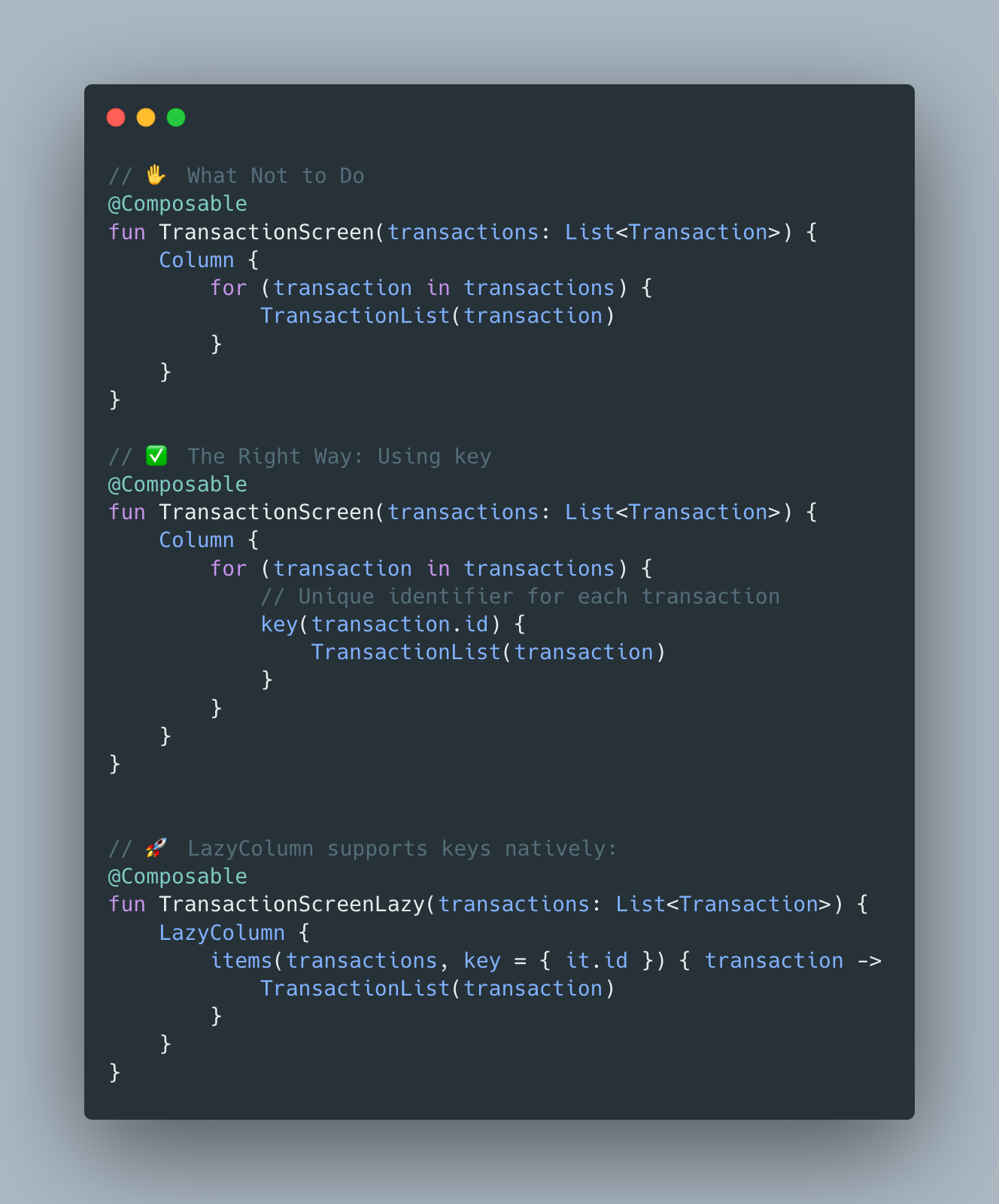When working with dynamic lists, like bank transactions, changes such as 𝗮𝗱𝗱𝗶𝗻𝗴 𝘁𝗼 𝘁𝗵𝗲 𝘁𝗼𝗽, 𝗿𝗲𝗼𝗿𝗱𝗲𝗿𝗶𝗻𝗴, 𝗼𝗿 𝗿𝗲𝗺𝗼𝘃𝗶𝗻𝗴 𝗶𝘁𝗲𝗺𝘀 𝗰𝗮𝗻 𝘁𝗿𝗶𝗴𝗴𝗲𝗿 𝘂𝗻𝗻𝗲𝗰𝗲𝘀𝘀𝗮𝗿𝘆 𝗿𝗲𝗰𝗼𝗺𝗽𝗼𝘀𝗶𝘁𝗶𝗼𝗻𝘀. This impacts performance and the user experience.
𝗨𝘀𝗶𝗻𝗴 𝗸𝗲𝘆 allows Jetpack Compose to uniquely identify each item and preserve its state even when its position changes.
🚩 𝗧𝗵𝗲 𝗽𝗿𝗼𝗯𝗹𝗲𝗺
Imagine a list of recent bank transactions:
– A new transaction is added at the top.
– An existing transaction is reordered.
Without optimisation, Compose will recompose every affected transaction, even if the data hasn’t changed. This can waste resources and disrupt smooth animations or in-progress operations, such as fetching an image.
By wrapping each item in a key, Compose can uniquely identify it and retain its state even if its position changes. Find an example below.
🚀 𝗪𝗵𝘆 𝘁𝗵𝗶𝘀 𝘄𝗼𝗿𝗸𝘀
🔸 Preserves state: Each transaction is tied to its unique id, so Compose understands that the transaction itself hasn’t changed, even if it moves in the list.
🔸 Avoids interruptions: Side effects, like network calls or animations, won’t restart unnecessarily.
🔸 Improves performance: Only the changed or added items are recomposed, reducing computational overhead.
🔧 𝗞𝗲𝘆 𝗽𝗼𝗶𝗻𝘁
Use the key composable to help Compose identify composable instances in the Composition. This is crucial when multiple composables are called from the same call site and involve side-effects or internal state.
Some composables, like 𝑳𝒂𝒛𝒚𝑪𝒐𝒍𝒖𝒎𝒏, offer built-in support for keys. For instance, you can specify a custom key directly in the items DSL.
🔗 𝗪𝗵𝘆 𝗶𝘁 𝗺𝗮𝘁𝘁𝗲𝗿𝘀
Efficient recomposition ensures smoother experiences, especially for dynamic and complex UIs like transaction lists in banking apps. By leveraging key, we align with Jetpack Compose’s optimised lifecycle management.
👉 Link to official documentation here.



